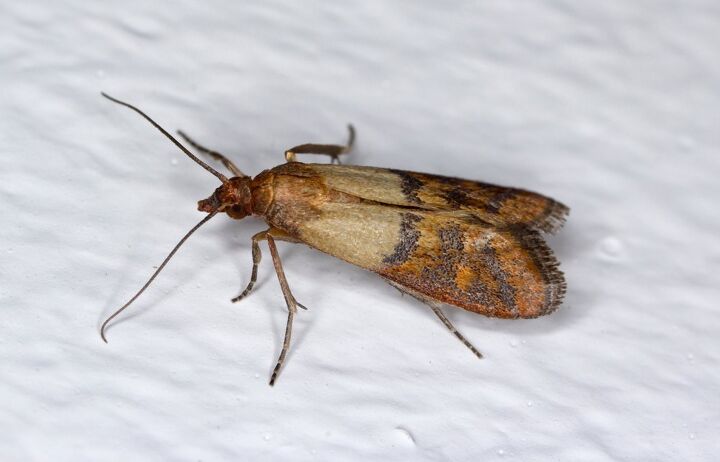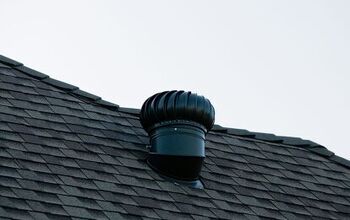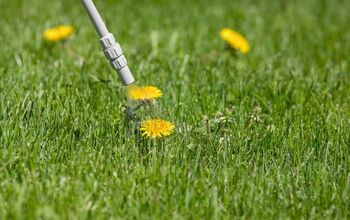10 Types Of House Moths (With Photos)

Moths are among the most unique and fascinating insects, but it’s not fun when you find them in your home. They fly around erratically and often look like colorless butterflies to the uninitiated, and that can frighten any homeowner. There are over 160,000 species of moths, but 10 of them are specifically none to live around households.
The most common types of household mouths are brown house moths, white-shouldered house moths, and Indian meal moths. You will also commonly find Mediterranean pantry moths and common clothes moths indoors in the folds of fabric. Pantry moths such as brown house moths and Indian meal moths are attracted to food and you can find them in your pantry.
Moths are typically harmless, but an infestation of any variety can be a hassle. That is why it is important to be able to identify common household moths and understand their patterns. Follow along as we take a look at the 10 most common household moths.
What is a Moth?
Moths are a part of the class of “Insecta,” which refers to insects, or invertebrates with three portions to its body and six legs. Both moths and butterflies are included in the order Lepidoptera – when translated means “scaly wings” as they feature big wings with scales on them. It is thought that there are nearly 160,000 species of moth, many of which have not been described yet.
There are four stages to the life of a moth – first is the “egg,” which hatches into a “larvae” known as a caterpillar. Caterpillars are eating machines that molt out of their skin numerous times as they grow. Each stage of growth is called an instar. Eventually, moths build cocoons where they go through metamorphism. The final stage is referred to as the adult, when the moth emerges from the cocoon and takes on its final form.
Types of House Moths
There are numerous types of moth species that can infest your home, each of which have slightly different appearances, lifespans, and behaviors. When you have a moth infestation in your home, there are two main types that are the most likely suspects: pantry moths and clothes moths. To help you determine which pest you’re dealing with, we’ve outlined the most common types of house moths below.
1. Brown House Moth
The Brown House Moth (Hofmannophila pseudospretella) is a part of the concealer moth family and likely originated from Asia. However, this type of moth was introduced to other regions of the world via human activity and can now be found all over the world. Brown House moths are commonly seen in the home. Adult Brown House moths grow to reach between 8mm and 14mm in length, with a wingspan between 15mm and 26 mm.
They are typically brown in color with three or four darker spots visible on the wings. Brown House moth larvae are roughly 6mm long and are off-white in color with a brown head. Caterpillars feed on organic debris that accumulates indoors, including oatmeal, rice, flour, biscuits, potatoes, as well as natural clothing and carpet fibers. Considered a scavenger, these moths are generally more destructive than the common clothes moth.
2. White-Shouldered House Moth
Although less common, the White-Shouldered House Moth (Endrosis sarcitrella) is attracted to light and because of its constant year-round breeding cycle it can be found in homes, factories, and outbuildings that contain dried food sources. These moths are omnivorous, consuming things like bran, grain, flour, and other cereals, as well as wool and other animal-derived fabrics.
Adult White-Shouldered House Moths reach between 8mm and 10mm in length and can be distinguished by their characteristic white head and mottled wings. The larvae have a cream color with a red head or they may be seen in a silk cocoon. These types of moths don’t typically cause significant damage to textiles, but the larvae are known to scavenge on a wide variety of foods.
3. Indian Meal Moth
The Indian Meal Moth (Plodia interpunctella) are also sometimes known simply as Pantry Moths or Flour Moths. Their larvae (caterpillars) are commonly referred to as “waxworms”. These moths are grain-feeding pests that can be found worldwide, feeding on cereals and similar food items.
Adult Indian Meal Moths range from 8mm to 10mm in length and a wingspan between 16mm and 20mm. They can be characterized by the bronze or dark grey color on the outer half of their forewings and a yellowy-gray color on the upper half and a dark band in between. Their larvae are off-white in color and have brown heads.
These moths can infest a wide range of dry food goods of vegetable origin, including dried fruits, rice, pasta, nuts, bread, and cereal. When infested, the food will appear like it is webbed together.
4. Mediterranean Pantry Moth
Also known as the Flour Moth or the Mediterranean Food Moth, this moth is larger than the Indian meal moth but develops and produces damage that is similar. Their favorite food is flour, but these moths may also attack bran, grains, and a variety of breakfast cereals. The lifespan of the Mediterranean Pantry Moth is about 10 weeks. Webbing and matting of the larvae tend to cause the most significant damage, whether it’s clogging machinery or contaminating food.
This type of moth can be easily identified when at rest, as it has a characteristic stance that involves extending the forelegs and raising the head to give it a sloping appearance. No other type of house moth has this sloping pose.
5. Common Clothes Moth
The Common Clothes Moth (Tineola bisselliella) is among the most damaging and commonly confronted house moths. Adult Common Clothes Moths reach between 6mm and 7mm in length and feature uniformly straw-colored fringed wings. They typically avoid light and, instead of flying, they run and will typically be seen crawling at floor level or resting on the walls.
The adults do not feed; but, their larvae feed on a wide array of materials and are responsible for producing irregular holes in fabrics. Common Clothes Moth larvae reach up to 10mm long and are cream colored with brown heads. In favorable conditions, they take about 6 weeks to reach adulthood.
6. Case-Bearing Clothes Moth
Another type of destructive house moth, the Case-Bearing Clothes Moth (Tinea pellionella) produces more regular holes in fabrics. These moths have a similar lifecycle to that of the Common Clothes Moth, but are rarer. The adult Case-Bearing Clothes Moth ranges in size from 6mm to 7mm long and is darker in color with three dim spots on each wing.
This moth gets its name because the larval caterpillar creates a silken cell around itself that it carries as it moves around and feeds. These cells are typically described as appearing like grains of rice, but if you look close enough you’ll usually see the head coming out of the case. Although less common, you’ll usually find these moths in imported goods like hides or other products of animal origin.
7. Fall Webworm Moth
Fall webworm moths are just as easy to spot as adults as they are when they are caterpillars. They begin their life as small white caterpillars with black dots on their backs. You can find their unique webbed nests in trees on the outskirts of forests.
You can expect more fall webworm moths in the spring and summer if you find webbed nests in the fall or winter. Luckily, their webs don’t harm trees unless it is already dying and you won’t need to treat them for fall webworm moth nests. They grow up to be mid-sized moths with a white body and small black dots.
Fall webworm moths are attracted to trees and you will find many of them if you live in a wooded area. Their natural predators include birds and spiders, and you can remove them on your own if you destroy their nests. However, fall webworm moths are harmless and there is no reason to worry about them.
8. Cecropia Moth
Cecropia moths are easy to spot because of their large size and massive wingspan. They are the largest moth in North America, and female cecropia moths have wingspans that measure up to 7” across. Cecropia caterpillars can be intimidating because of the bristles on their back, but they are harmless.
Generally, bristles indicate that a caterpillar may be poisonous, but that isn’t the case with cecropia moths. They are attracted to hardwood and that is where cecropia moths lay their eggs. Cecropia moths are active at night, and it is rare to find them indoors unless you live on the edge of a forest.
However, it is common to see them flying around in the darkness at night feeding on trees and shrubs. Cecropia moths rarely live longer than 2 weeks as adults, but their entire lifespan lasts 1 year.
9. Hummingbird Clearwing Moth
Hummingbird clearwing moths are just as drawn to gardens as butterflies, and they can help with pollination. You will likely find hummingbird clearwing moths in your garden if you have plants that produce nectar such as coral honeysuckle.
A hummingbird clearwing moth survives for an average of 1 week as an adult, but they live as pupae for all of winter. Their bodies are thick, fuzzy, and have large clear wings. You can identify a hummingbird clearwing moth for the distinct brown or black border around their clear wings.
Their bodies are generally yellow and black, but hummingbird clearwing moths sometimes have fuzzy olive backs. Hummingbird clearwing moths are some of the most beneficial pollinators that you can find in your garden. It is unlikely that you will find them inside yourself, but they may get lost in the spring or summer and wind up indoors.
10. Isabella Tiger Moth
You are more likely to recognize an Isabella tiger moth as a caterpillar than as a fully developed moth. Isabella tiger moth caterpillars are easy to spot with the brown and back pattern on their backs. They eventually grow into large moths with an average 1.62” wingspan.
Some Isabella tiger moths have large wingspans that measure up to 2.5”. People have used Isabella tiger moths as a way to predict the winter for decades. It isn’t an ironclad method, but many people look at the band on an Isabella tiger moth’s back to determine how long winter will last.
You can generally find Isabella tiger moths lingering around low plants such as dandelions, plantains, and grass. Isabella tiger moths lay their eggs on these low-lying plants, and they typically only live for 1-2 weeks. Luckily, they are harmless to people, but some people have had allergic reactions when touching them as caterpillars.
Pantry Moths Vs. Clothes Moths
It can be difficult to distinguish pantry moths and clothes moths if you aren’t familiar with them. Both varieties fly around quickly and are a nuisance when you find them in your home. However, pantry moths and clothes moths are attracted to different things, behave differently, and have unique appearances.
Clothes Moths
As their name suggests, clothes moths commonly feed on natural fibers such as fur, linen, silk, and wool. They are known to infest dark spaces like closets, wardrobes, attic spaces, and are often found nestled in the folds of fabric. Clothes moths are notorious for ruining pillows, sweaters, comforters, coats, and may even feed on carpeting.
Signs that indicate a clothes moth infestation include webbing, holes in the fabric, and excrement which appears like large grains of sand. You may also find their silk cases, which are long, cylindrical, open on the end, and include pieces of infested material inside the case. If the case is still occupied, it will have a squirming larva inside.
Pantry Moths
There are numerous types of pantry moths, but all will collect where there is a food supply. You’ll often find them in your kitchen pantry – hence the name – where grains, crackers, cereals, rice, and other dry goods are stored. These moths are also known for eating spices, nuts, and even chocolate.
A good indication of a pantry moth infestation is webbing or tiny larvae squirming around inside your food containers when you open them. Pantry moths generally only last for a few days once they get inside of your home.
How to Get Rid of Moths in the Home
Moths are typically harmless, but they can be a nuisance if you find them inside of your house. They are often attracted to the light, fabric, and food. Luckily, it is easy to get rid of moths inside of your home if you take simple steps, such as:
- Wash vulnerable fabrics. This includes natural materials and soft furnishing near the infestation.
- Clean thoroughly. Vacuum carpets and pay attention to areas that are often neglected – such as along the skirting or behind or underneath furniture.
- Vacuum on a regular basis. Get rid of larvae before the infestation can spread and empty the vacuum bag outside immediately.
- Use cedar clothes hangers. Moths don’t like the smell and will be less likely to eat your clothes.

Jessica considers herself a home improvement and design enthusiast. She grew up surrounded by constant home improvement projects and owes most of what she knows to helping her dad renovate her childhood home. Being a Los Angeles resident, Jessica spends a lot of her time looking for her next DIY project and sharing her love for home design.
More by Jessica Stone





































